engine SATURN ION 2007 Owner's Manual
[x] Cancel search | Manufacturer: SATURN, Model Year: 2007, Model line: ION, Model: SATURN ION 2007Pages: 440, PDF Size: 2.93 MB
Page 159 of 440

The air-conditioning system removes moisture
from the air, so you may sometimes notice a small
amount of water dripping underneath your
vehicle while idling or after turning off the engine.
This is normal.
Defogging and Defrosting
Fog on the inside of windows is a result of high
humidity (moisture) condensing on the cool window
glass. This can be minimized if the climate
control system is used properly. There are
two modes to clear fog or frost from your
windshield and side windows. Use the defog mode
to clear the windows of fog or moisture and
warm the passengers. Use the defrost mode to
remove fog or frost from the windshield more
quickly. For best results, clear all snow and ice
from the windshield before defrosting.Turn the left knob to select the defog or
defrost mode.
-(Defog):This mode directs half of the air to the
windshield and the side window outlets and half to
the �oor outlets. When you select this mode the
system runs the air-conditioning compressor. To
defog the windows faster, turn the temperature
control knob clockwise to the warmest setting.
0(Defrost):This mode directs most of the air to
the windshield, with some air directed to the
side window outlets and the �oor outlets. When
you select this mode the system runs the
air-conditioning compressor.
159
ProCarManuals.com
Page 160 of 440
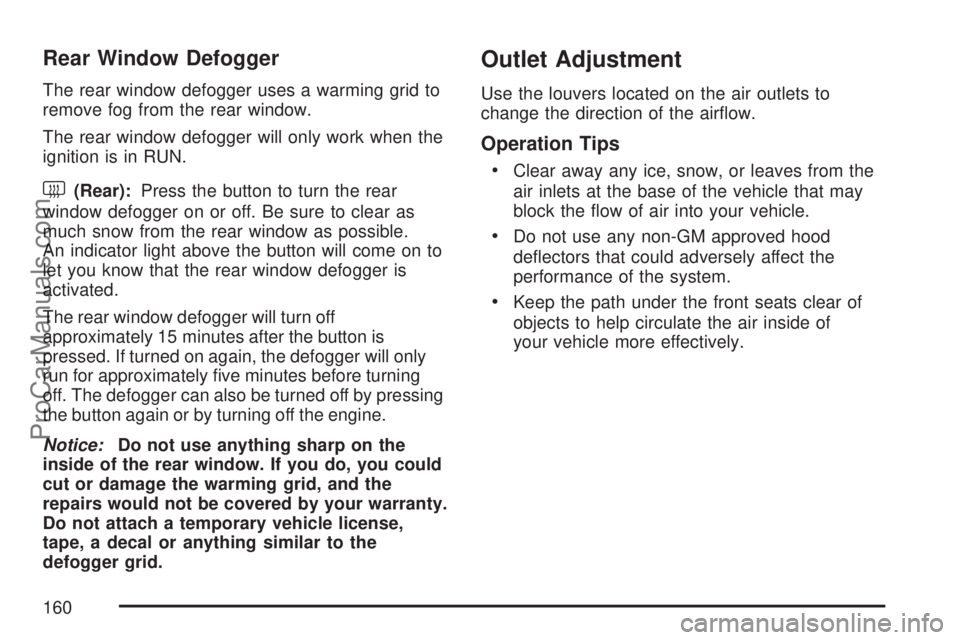
Rear Window Defogger
The rear window defogger uses a warming grid to
remove fog from the rear window.
The rear window defogger will only work when the
ignition is in RUN.
<(Rear):Press the button to turn the rear
window defogger on or off. Be sure to clear as
much snow from the rear window as possible.
An indicator light above the button will come on to
let you know that the rear window defogger is
activated.
The rear window defogger will turn off
approximately 15 minutes after the button is
pressed. If turned on again, the defogger will only
run for approximately �ve minutes before turning
off. The defogger can also be turned off by pressing
the button again or by turning off the engine.
Notice:Do not use anything sharp on the
inside of the rear window. If you do, you could
cut or damage the warming grid, and the
repairs would not be covered by your warranty.
Do not attach a temporary vehicle license,
tape, a decal or anything similar to the
defogger grid.
Outlet Adjustment
Use the louvers located on the air outlets to
change the direction of the air�ow.
Operation Tips
Clear away any ice, snow, or leaves from the
air inlets at the base of the vehicle that may
block the �ow of air into your vehicle.
Do not use any non-GM approved hood
de�ectors that could adversely affect the
performance of the system.
Keep the path under the front seats clear of
objects to help circulate the air inside of
your vehicle more effectively.
160
ProCarManuals.com
Page 163 of 440
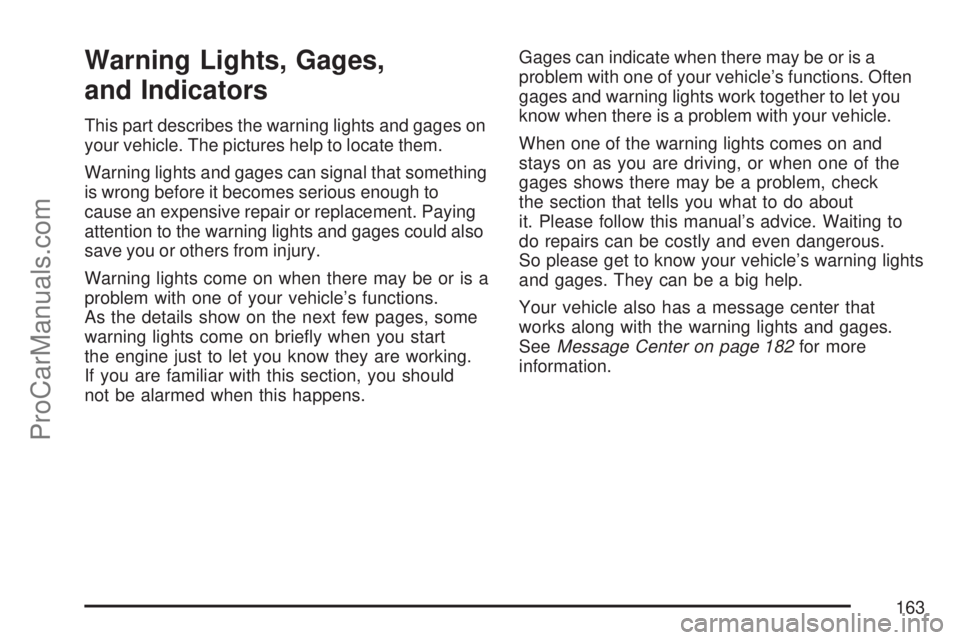
Warning Lights, Gages,
and Indicators
This part describes the warning lights and gages on
your vehicle. The pictures help to locate them.
Warning lights and gages can signal that something
is wrong before it becomes serious enough to
cause an expensive repair or replacement. Paying
attention to the warning lights and gages could also
save you or others from injury.
Warning lights come on when there may be or is a
problem with one of your vehicle’s functions.
As the details show on the next few pages, some
warning lights come on brie�y when you start
the engine just to let you know they are working.
If you are familiar with this section, you should
not be alarmed when this happens.Gages can indicate when there may be or is a
problem with one of your vehicle’s functions. Often
gages and warning lights work together to let you
know when there is a problem with your vehicle.
When one of the warning lights comes on and
stays on as you are driving, or when one of the
gages shows there may be a problem, check
the section that tells you what to do about
it. Please follow this manual’s advice. Waiting to
do repairs can be costly and even dangerous.
So please get to know your vehicle’s warning lights
and gages. They can be a big help.
Your vehicle also has a message center that
works along with the warning lights and gages.
SeeMessage Center on page 182for more
information.
163
ProCarManuals.com
Page 165 of 440
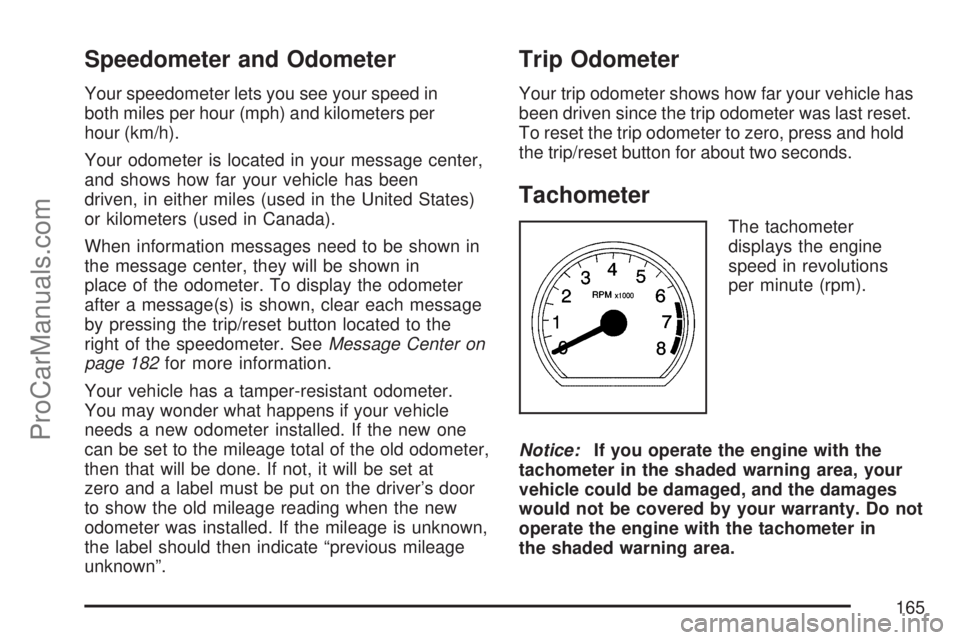
Speedometer and Odometer
Your speedometer lets you see your speed in
both miles per hour (mph) and kilometers per
hour (km/h).
Your odometer is located in your message center,
and shows how far your vehicle has been
driven, in either miles (used in the United States)
or kilometers (used in Canada).
When information messages need to be shown in
the message center, they will be shown in
place of the odometer. To display the odometer
after a message(s) is shown, clear each message
by pressing the trip/reset button located to the
right of the speedometer. SeeMessage Center on
page 182for more information.
Your vehicle has a tamper-resistant odometer.
You may wonder what happens if your vehicle
needs a new odometer installed. If the new one
can be set to the mileage total of the old odometer,
then that will be done. If not, it will be set at
zero and a label must be put on the driver’s door
to show the old mileage reading when the new
odometer was installed. If the mileage is unknown,
the label should then indicate “previous mileage
unknown”.
Trip Odometer
Your trip odometer shows how far your vehicle has
been driven since the trip odometer was last reset.
To reset the trip odometer to zero, press and hold
the trip/reset button for about two seconds.
Tachometer
The tachometer
displays the engine
speed in revolutions
per minute (rpm).
Notice:If you operate the engine with the
tachometer in the shaded warning area, your
vehicle could be damaged, and the damages
would not be covered by your warranty. Do not
operate the engine with the tachometer in
the shaded warning area.
165
ProCarManuals.com
Page 170 of 440
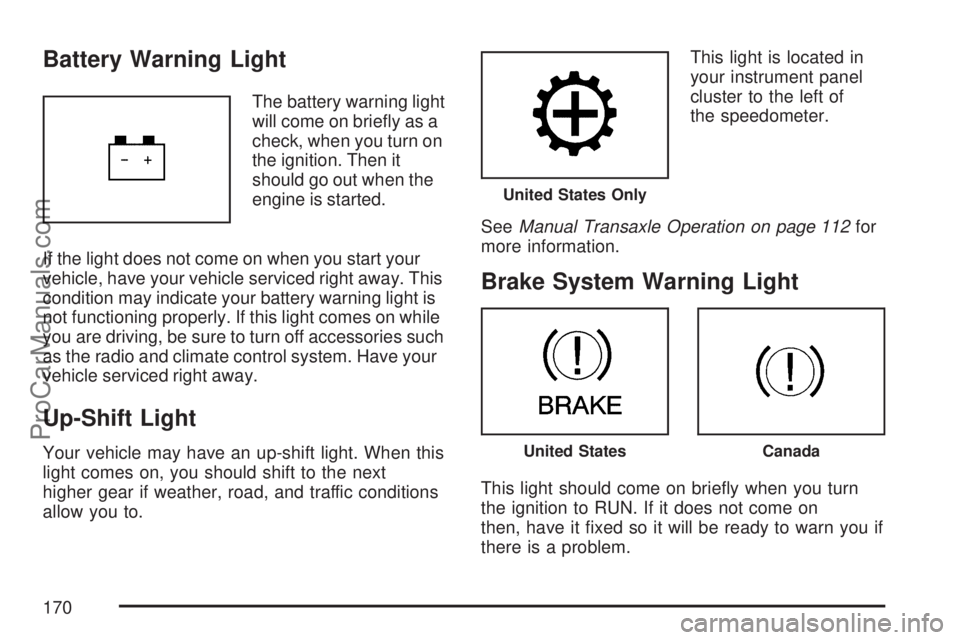
Battery Warning Light
The battery warning light
will come on brie�y as a
check, when you turn on
the ignition. Then it
should go out when the
engine is started.
If the light does not come on when you start your
vehicle, have your vehicle serviced right away. This
condition may indicate your battery warning light is
not functioning properly. If this light comes on while
you are driving, be sure to turn off accessories such
as the radio and climate control system. Have your
vehicle serviced right away.
Up-Shift Light
Your vehicle may have an up-shift light. When this
light comes on, you should shift to the next
higher gear if weather, road, and traffic conditions
allow you to.This light is located in
your instrument panel
cluster to the left of
the speedometer.
SeeManual Transaxle Operation on page 112for
more information.
Brake System Warning Light
This light should come on brie�y when you turn
the ignition to RUN. If it does not come on
then, have it �xed so it will be ready to warn you if
there is a problem.
United States Only
United StatesCanada
170
ProCarManuals.com
Page 172 of 440
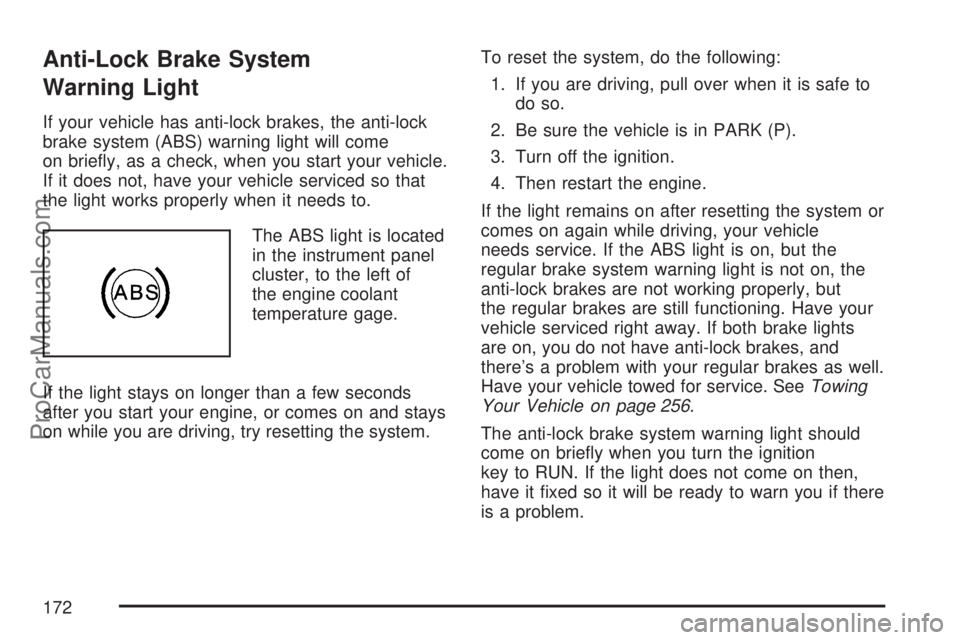
Anti-Lock Brake System
Warning Light
If your vehicle has anti-lock brakes, the anti-lock
brake system (ABS) warning light will come
on brie�y, as a check, when you start your vehicle.
If it does not, have your vehicle serviced so that
the light works properly when it needs to.
The ABS light is located
in the instrument panel
cluster, to the left of
the engine coolant
temperature gage.
If the light stays on longer than a few seconds
after you start your engine, or comes on and stays
on while you are driving, try resetting the system.To reset the system, do the following:
1. If you are driving, pull over when it is safe to
do so.
2. Be sure the vehicle is in PARK (P).
3. Turn off the ignition.
4. Then restart the engine.
If the light remains on after resetting the system or
comes on again while driving, your vehicle
needs service. If the ABS light is on, but the
regular brake system warning light is not on, the
anti-lock brakes are not working properly, but
the regular brakes are still functioning. Have your
vehicle serviced right away. If both brake lights
are on, you do not have anti-lock brakes, and
there’s a problem with your regular brakes as well.
Have your vehicle towed for service. SeeTowing
Your Vehicle on page 256.
The anti-lock brake system warning light should
come on brie�y when you turn the ignition
key to RUN. If the light does not come on then,
have it �xed so it will be ready to warn you if there
is a problem.
172
ProCarManuals.com
Page 173 of 440
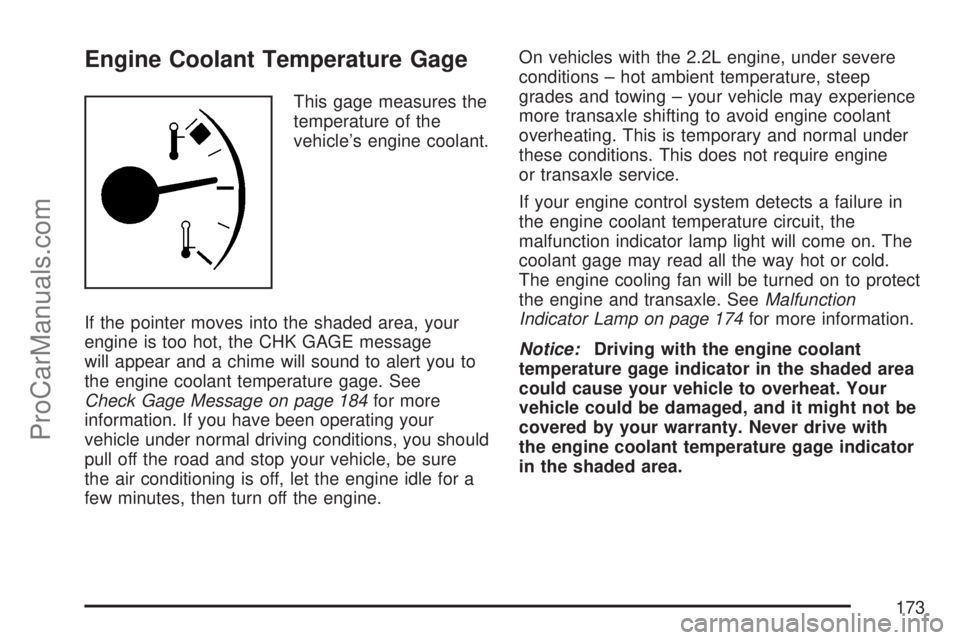
Engine Coolant Temperature Gage
This gage measures the
temperature of the
vehicle’s engine coolant.
If the pointer moves into the shaded area, your
engine is too hot, the CHK GAGE message
will appear and a chime will sound to alert you to
the engine coolant temperature gage. See
Check Gage Message on page 184for more
information. If you have been operating your
vehicle under normal driving conditions, you should
pull off the road and stop your vehicle, be sure
the air conditioning is off, let the engine idle for a
few minutes, then turn off the engine.On vehicles with the 2.2L engine, under severe
conditions – hot ambient temperature, steep
grades and towing – your vehicle may experience
more transaxle shifting to avoid engine coolant
overheating. This is temporary and normal under
these conditions. This does not require engine
or transaxle service.
If your engine control system detects a failure in
the engine coolant temperature circuit, the
malfunction indicator lamp light will come on. The
coolant gage may read all the way hot or cold.
The engine cooling fan will be turned on to protect
the engine and transaxle. SeeMalfunction
Indicator Lamp on page 174for more information.
Notice:Driving with the engine coolant
temperature gage indicator in the shaded area
could cause your vehicle to overheat. Your
vehicle could be damaged, and it might not be
covered by your warranty. Never drive with
the engine coolant temperature gage indicator
in the shaded area.
173
ProCarManuals.com
Page 174 of 440
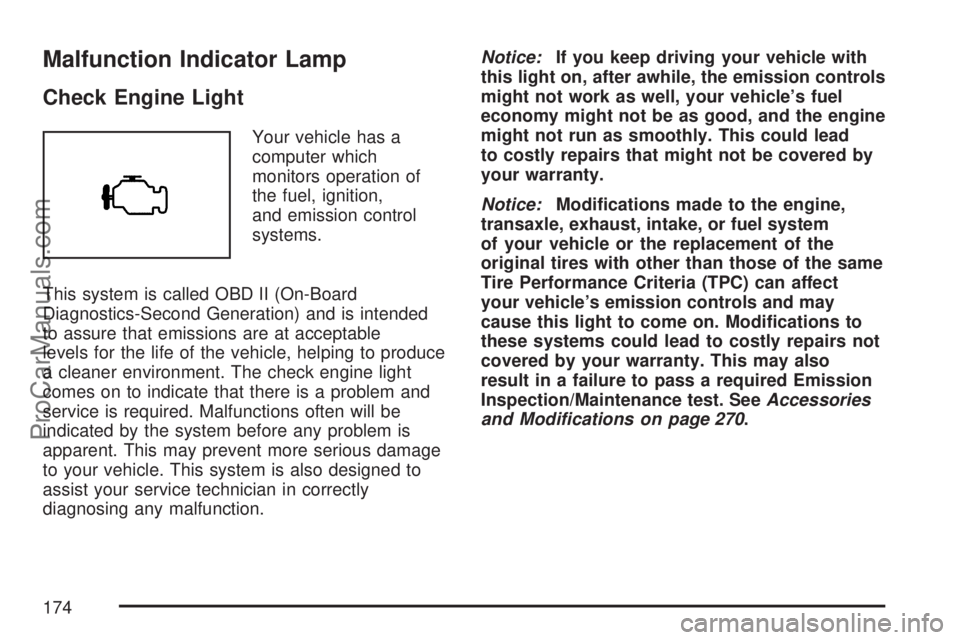
Malfunction Indicator Lamp
Check Engine Light
Your vehicle has a
computer which
monitors operation of
the fuel, ignition,
and emission control
systems.
This system is called OBD II (On-Board
Diagnostics-Second Generation) and is intended
to assure that emissions are at acceptable
levels for the life of the vehicle, helping to produce
a cleaner environment. The check engine light
comes on to indicate that there is a problem and
service is required. Malfunctions often will be
indicated by the system before any problem is
apparent. This may prevent more serious damage
to your vehicle. This system is also designed to
assist your service technician in correctly
diagnosing any malfunction.Notice:If you keep driving your vehicle with
this light on, after awhile, the emission controls
might not work as well, your vehicle’s fuel
economy might not be as good, and the engine
might not run as smoothly. This could lead
to costly repairs that might not be covered by
your warranty.
Notice:Modi�cations made to the engine,
transaxle, exhaust, intake, or fuel system
of your vehicle or the replacement of the
original tires with other than those of the same
Tire Performance Criteria (TPC) can affect
your vehicle’s emission controls and may
cause this light to come on. Modi�cations to
these systems could lead to costly repairs not
covered by your warranty. This may also
result in a failure to pass a required Emission
Inspection/Maintenance test. SeeAccessories
and Modifications on page 270.
174
ProCarManuals.com
Page 175 of 440
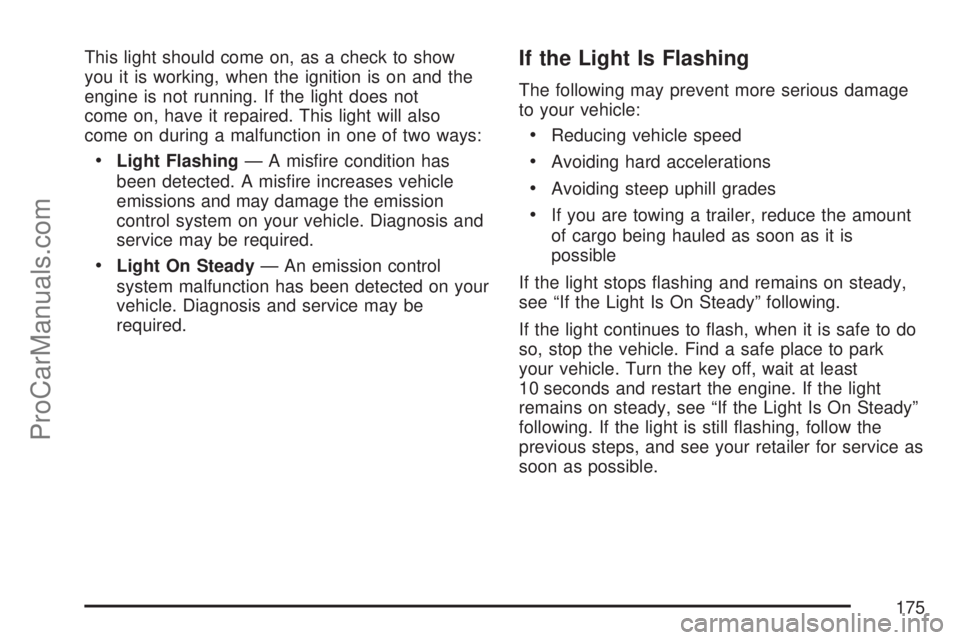
This light should come on, as a check to show
you it is working, when the ignition is on and the
engine is not running. If the light does not
come on, have it repaired. This light will also
come on during a malfunction in one of two ways:
Light Flashing— A mis�re condition has
been detected. A mis�re increases vehicle
emissions and may damage the emission
control system on your vehicle. Diagnosis and
service may be required.
Light On Steady— An emission control
system malfunction has been detected on your
vehicle. Diagnosis and service may be
required.
If the Light Is Flashing
The following may prevent more serious damage
to your vehicle:
Reducing vehicle speed
Avoiding hard accelerations
Avoiding steep uphill grades
If you are towing a trailer, reduce the amount
of cargo being hauled as soon as it is
possible
If the light stops �ashing and remains on steady,
see “If the Light Is On Steady” following.
If the light continues to �ash, when it is safe to do
so, stop the vehicle. Find a safe place to park
your vehicle. Turn the key off, wait at least
10 seconds and restart the engine. If the light
remains on steady, see “If the Light Is On Steady”
following. If the light is still �ashing, follow the
previous steps, and see your retailer for service as
soon as possible.
175
ProCarManuals.com
Page 176 of 440
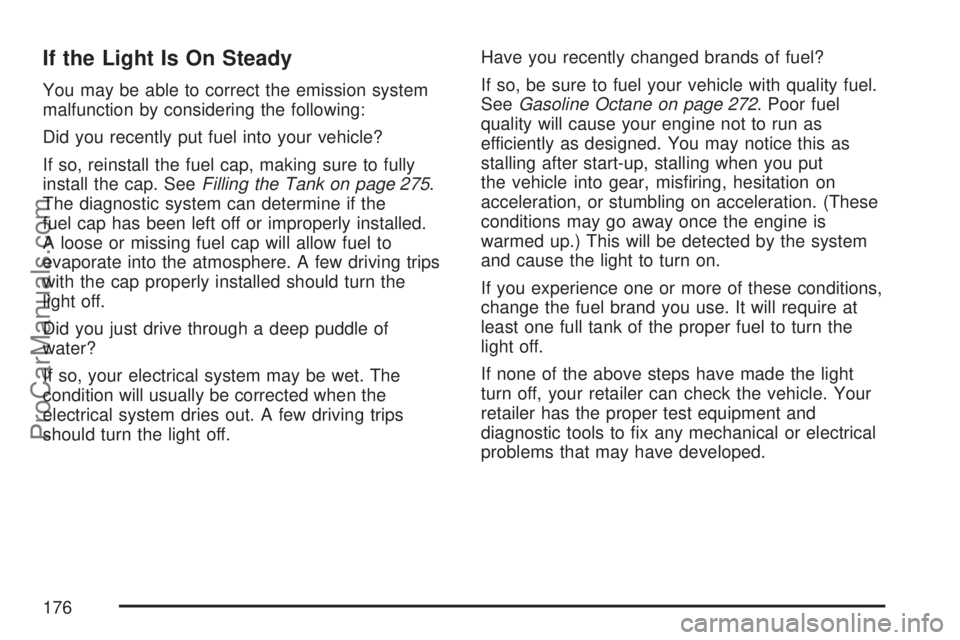
If the Light Is On Steady
You may be able to correct the emission system
malfunction by considering the following:
Did you recently put fuel into your vehicle?
If so, reinstall the fuel cap, making sure to fully
install the cap. SeeFilling the Tank on page 275.
The diagnostic system can determine if the
fuel cap has been left off or improperly installed.
A loose or missing fuel cap will allow fuel to
evaporate into the atmosphere. A few driving trips
with the cap properly installed should turn the
light off.
Did you just drive through a deep puddle of
water?
If so, your electrical system may be wet. The
condition will usually be corrected when the
electrical system dries out. A few driving trips
should turn the light off.Have you recently changed brands of fuel?
If so, be sure to fuel your vehicle with quality fuel.
SeeGasoline Octane on page 272. Poor fuel
quality will cause your engine not to run as
efficiently as designed. You may notice this as
stalling after start-up, stalling when you put
the vehicle into gear, mis�ring, hesitation on
acceleration, or stumbling on acceleration. (These
conditions may go away once the engine is
warmed up.) This will be detected by the system
and cause the light to turn on.
If you experience one or more of these conditions,
change the fuel brand you use. It will require at
least one full tank of the proper fuel to turn the
light off.
If none of the above steps have made the light
turn off, your retailer can check the vehicle. Your
retailer has the proper test equipment and
diagnostic tools to �x any mechanical or electrical
problems that may have developed.
176
ProCarManuals.com